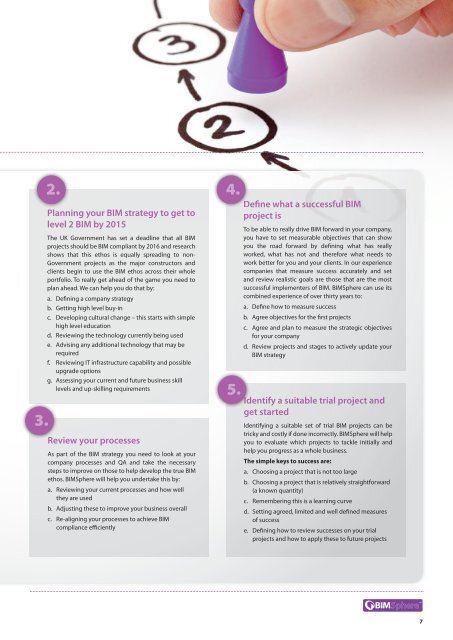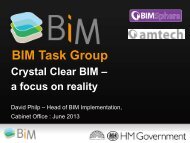Download our BIM Consultancy Guide - Amtech
Download our BIM Consultancy Guide - Amtech
Download our BIM Consultancy Guide - Amtech
You also want an ePaper? Increase the reach of your titles
YUMPU automatically turns print PDFs into web optimized ePapers that Google loves.
3.<br />
2.<br />
Planning y<strong>our</strong> <strong>BIM</strong> strategy to get to<br />
level 2 <strong>BIM</strong> by 2015<br />
The UK Government has set a deadline that all <strong>BIM</strong><br />
projects should be <strong>BIM</strong> compliant by 2016 and research<br />
shows that this ethos is equally spreading to non-<br />
Government projects as the major constructors and<br />
clients begin to use the <strong>BIM</strong> ethos across their whole<br />
portfolio. To really get ahead of the game you need to<br />
plan ahead. We can help you do that by:<br />
a. Defining a company strategy<br />
b. Getting high level buy-in<br />
c. Developing cultural change – this starts with simple<br />
high level education<br />
d. Reviewing the technology currently being used<br />
e. Advising any additional technology that may be<br />
required<br />
f. Reviewing IT infrastructure capability and possible<br />
upgrade options<br />
g. Assessing y<strong>our</strong> current and future business skill<br />
levels and up-skilling requirements<br />
Review y<strong>our</strong> processes<br />
As part of the <strong>BIM</strong> strategy you need to look at y<strong>our</strong><br />
company processes and QA and take the necessary<br />
steps to improve on those to help develop the true <strong>BIM</strong><br />
ethos. <strong>BIM</strong>Sphere will help you undertake this by:<br />
a. Reviewing y<strong>our</strong> current processes and how well<br />
they are used<br />
b. Adjusting these to improve y<strong>our</strong> business overall<br />
c. Re-aligning y<strong>our</strong> processes to achieve <strong>BIM</strong><br />
compliance efficiently<br />
4.<br />
5.<br />
Define what a successful <strong>BIM</strong><br />
project is<br />
To be able to really drive <strong>BIM</strong> forward in y<strong>our</strong> company,<br />
you have to set measurable objectives that can show<br />
you the road forward by defining what has really<br />
worked, what has not and therefore what needs to<br />
work better for you and y<strong>our</strong> clients. In <strong>our</strong> experience<br />
companies that measure success accurately and set<br />
and review realistic goals are those that are the most<br />
successful implementers of <strong>BIM</strong>. <strong>BIM</strong>Sphere can use its<br />
combined experience of over thirty years to:<br />
a. Define how to measure success<br />
b. Agree objectives for the first projects<br />
c. Agree and plan to measure the strategic objectives<br />
for y<strong>our</strong> company<br />
d. Review projects and stages to actively update y<strong>our</strong><br />
<strong>BIM</strong> strategy<br />
Identify a suitable trial project and<br />
get started<br />
Identifying a suitable set of trial <strong>BIM</strong> projects can be<br />
tricky and costly if done incorrectly. <strong>BIM</strong>Sphere will help<br />
you to evaluate which projects to tackle initially and<br />
help you progress as a whole business.<br />
The simple keys to success are:<br />
a. Choosing a project that is not too large<br />
b. Choosing a project that is relatively straightforward<br />
(a known quantity)<br />
c. Remembering this is a learning curve<br />
d. Setting agreed, limited and well defined measures<br />
of success<br />
e. Defining how to review successes on y<strong>our</strong> trial<br />
projects and how to apply these to future projects<br />
7










